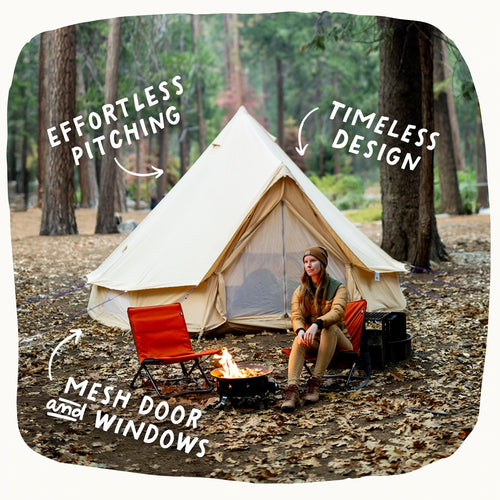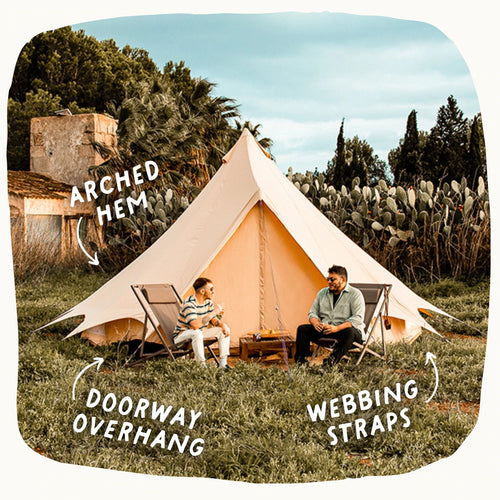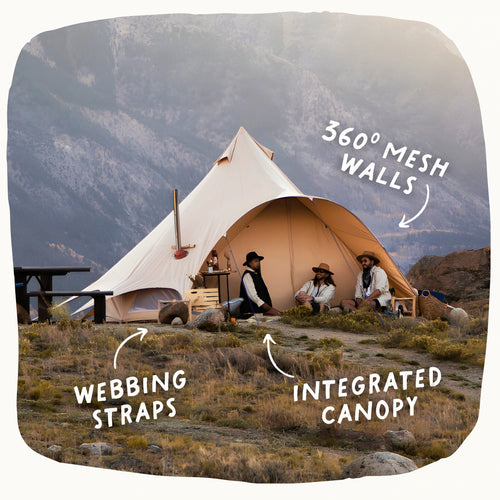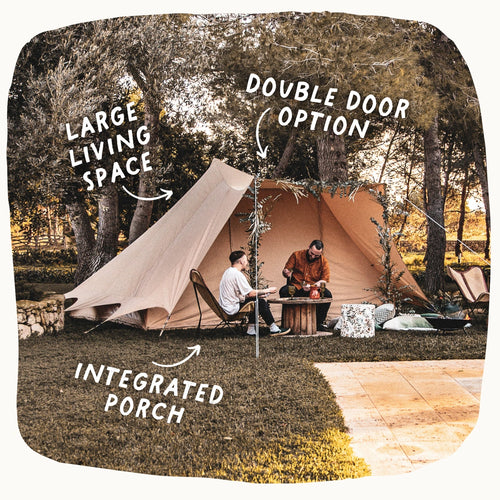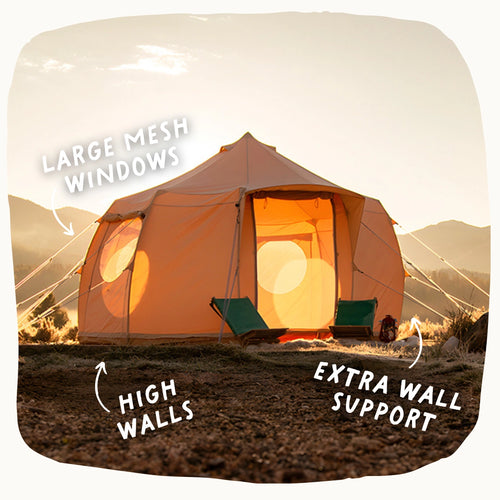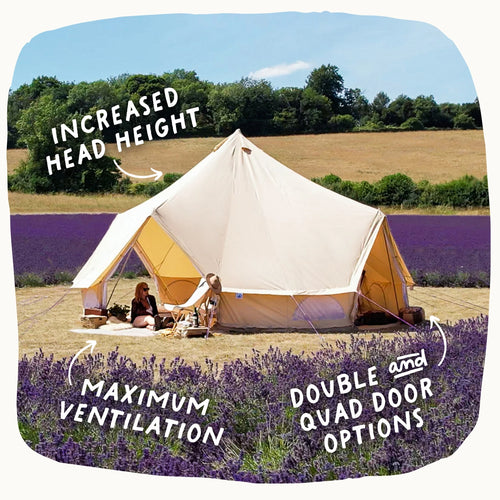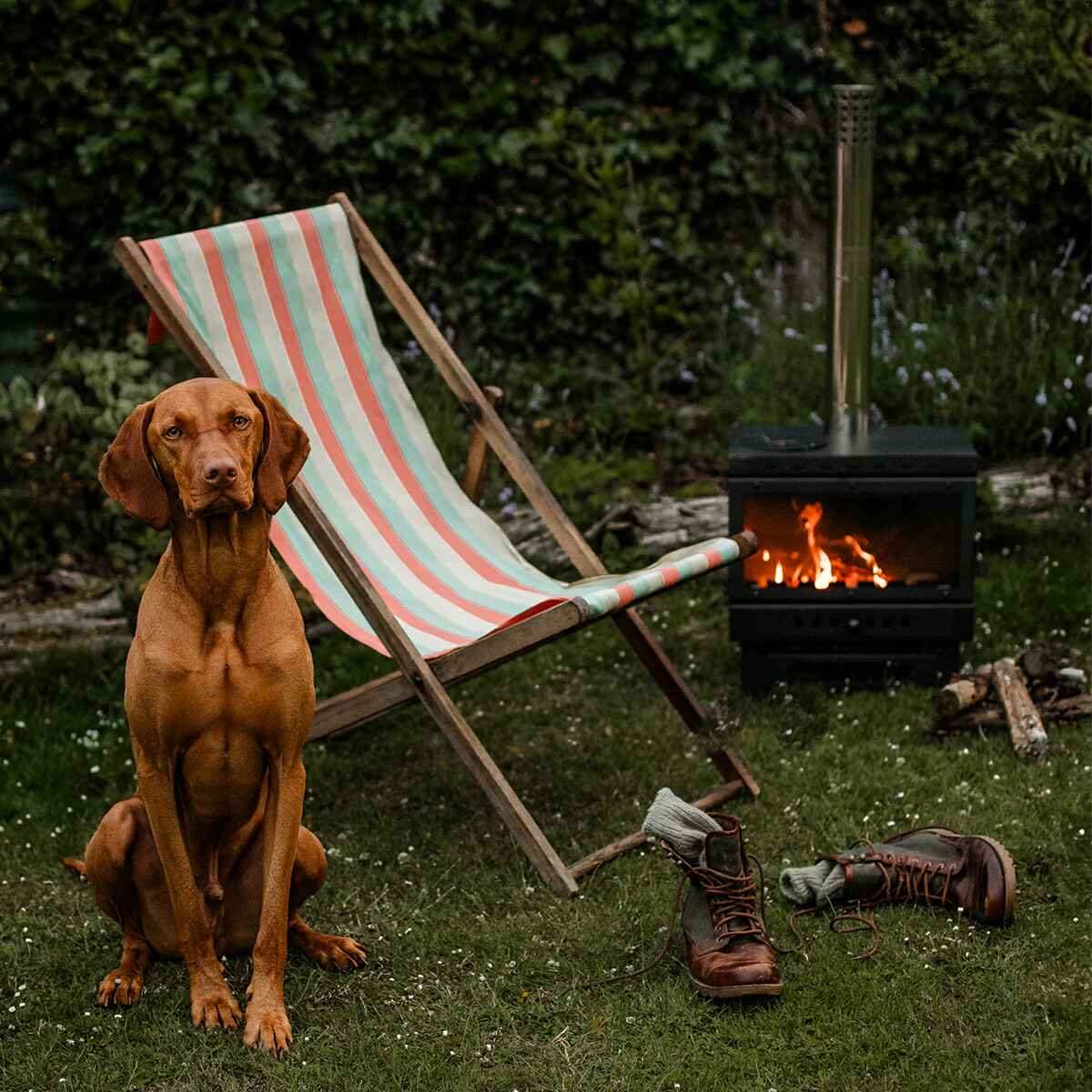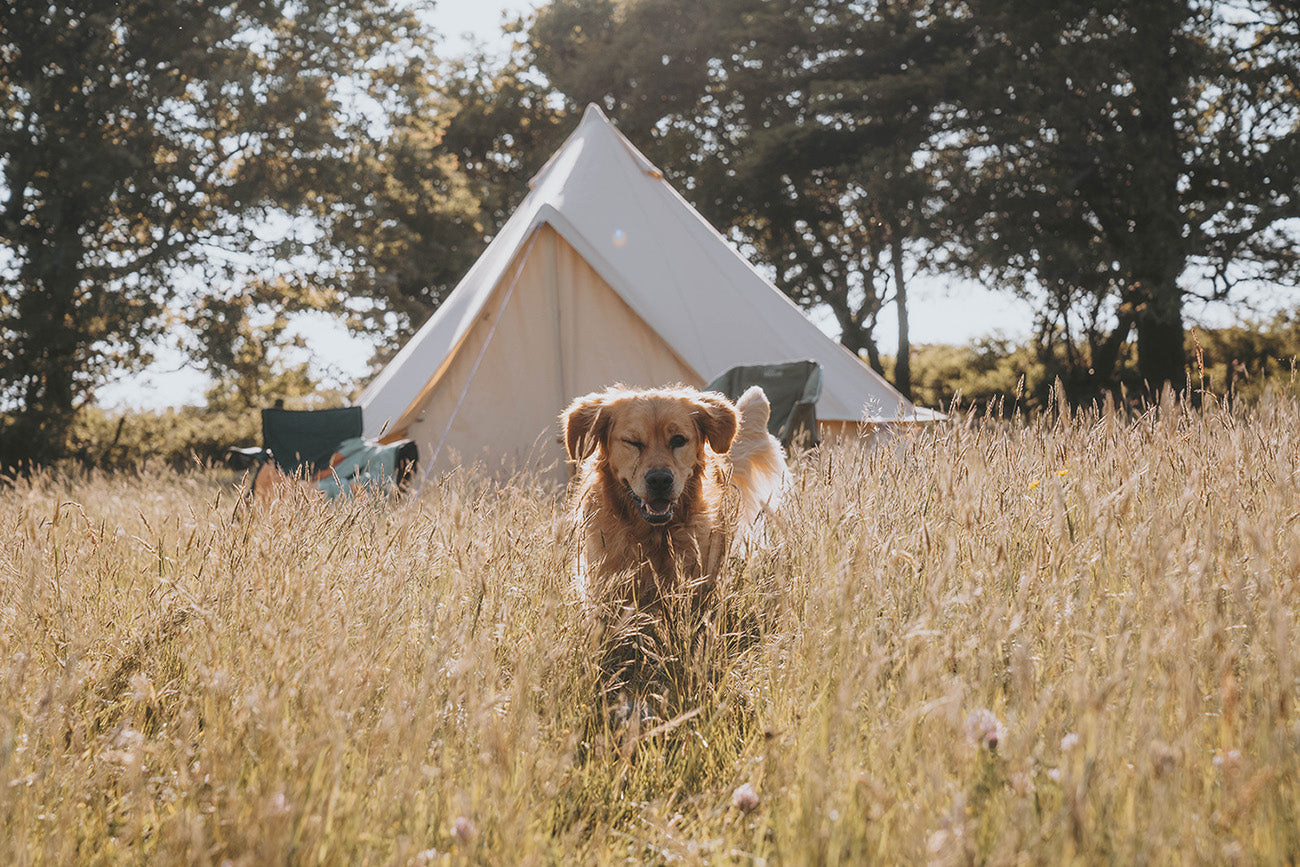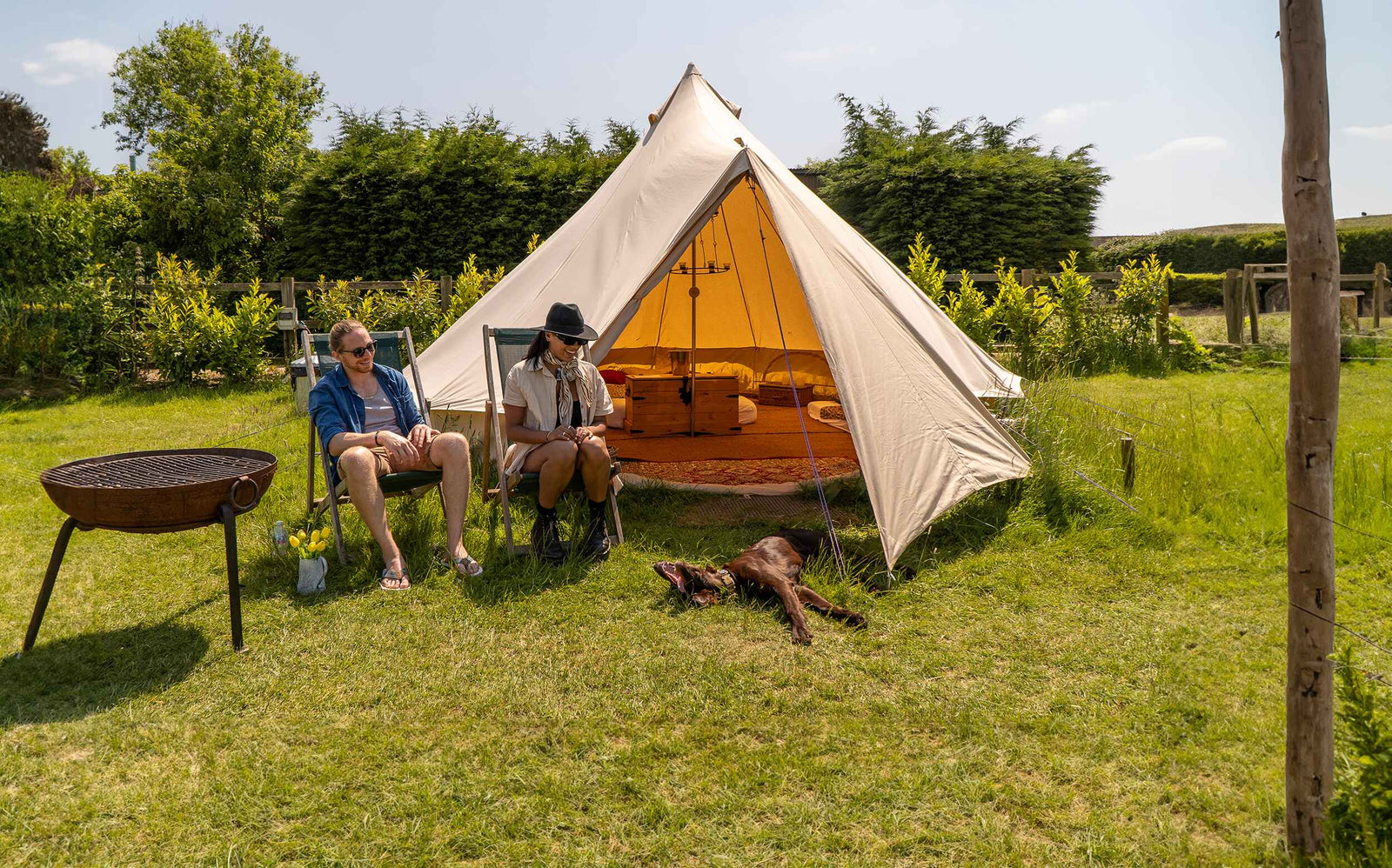The ultimate guide to camping with dogs
Bringing your furry friend along on a camping trip can take the experience to a whole new level of fun and adventure. But, just like any travel companion, your dog requires some special considerations to ensure a safe and enjoyable outdoor experience for everyone.
In this guide, we'll dive into everything you need to know about camping with dogs, from preparation to execution, so you and your pooch can make the most out of your outdoor escapades. We’ll cover:
is your dog ready?
Before camping with your dog, it's a good idea to make sure they’re ready for the adventure ahead. Start by evaluating your dog's overall health and fitness level, make sure they are up to date with vaccinations and parasite preventatives, and consider consulting with your vet to confirm that your dog is healthy enough for a camping trip if you have any concerns.
Gradually increase the duration and intensity of your walks to gauge your dog's endurance levels and build up their stamina before tackling longer hikes.
You’ll also need to consider your dog's temperament and behaviour. Dogs that are calm, well-behaved, and adaptable to new surroundings are generally better suited for camping. Pay attention to how your dog reacts to unfamiliar sights, sounds, and smells. Basic obedience skills are essential, so make sure your pup responds reliably to commands such as "sit," "stay," "come," and "leave it." A well-trained dog is not only safer in the countryside but also easier to manage in potentially challenging situations.
Whether you’re solo camping with your dog or taking the whole family, camping often involves encountering other campers and wildlife. So, it's important that your dog is comfortable and well socialised around strangers and other dogs. If your dog tends to be fearful or aggressive in social situations, work on desensitisation and positive reinforcement training before heading out on your camping trip. Remember that every dog is unique, so tailor your preparations and expectations to suit your furry companion's individual needs and abilities.
Best places for camping with your dogs
Whether you prefer secluded wilderness or family-friendly campgrounds, selecting the right camping spot is essential for a successful trip with your furry friend. Start your search by looking for campgrounds that explicitly welcome pets — many campgrounds have pet policies outlined on their websites or in camping directories. Better yet, look for campgrounds that also offer amenities such as dog-friendly trails, designated pet areas, and pet waste disposal stations. Reading reviews from other campers can provide valuable insights into the pet-friendliness of a campground.
Before booking, familiarise yourself with the campground's rules and regulations. Some campgrounds may have restrictions on the number or size of pets allowed, lead requirements, and pet-free zones. Make sure you understand and are willing to comply with these rules to ensure a smooth camping experience for everyone.
Finally, consider your dog's comfort and preferences when choosing a campground. If your dog is more anxious around crowds or noise, a secluded wilderness campground may be more suitable. On the other hand, if your dog enjoys socialising with other pets and people, a family-friendly campground with communal areas may be a better fit.
If you have specific questions or concerns about bringing your dog to a campground, don't hesitate to reach out to the managers directly. Contacting the campground can provide clarity on their pet policies, facilities, and any additional information you may need to plan your trip effectively.
Best tents for camping with dogs
Once you've arrived at your chosen destination, it's time to set up camp and settle in for a night under the stars. But with a furry friend in tow, there are a few extra considerations to keep in mind to ensure both you and your dog have a comfortable stay.
Select a tent that accommodates both you and your dog comfortably — a bell tent would be ideal for this. Look for a model with enough space for your pup to stretch out and move around without feeling cramped. An inner tent could be good for making a separate og bed area, and a tent with multiple entrances can also be beneficial. Tents with porches can provide the dog with a shaded area, and these are also good for keeping their food and drink bowls out the sun. You can also add a canopy or awning to the front if your tent doesn't have this feature.
For a spacious and well-ventilated camping solution, we recommend a Star bell tent with integrated canopy and 360° netting. With ample room for both you and your furry friend to walk around, stretch out, and relax, it's the perfect home away from home for your next outdoor adventure. The ventilation also ensures your pup can stay cool and prevent overheating, as well as keep things fresh indoors.
Additionally, be sure to check out our selection of camping accessories, including stoves, floormats, and bedding, to enhance your camping experience with your dog. If your dog is used to sleeping in a crate at home, consider bringing it along to give them a familiar and secure sleeping space in the tent.
It's natural for your dog to feel a bit anxious or excited in a new environment, so give them some time to adjust to their surroundings. Spend some calm quality time with your pup inside the tent, offering reassurance and praise to help them feel at ease. You could even do this in the garden at home before you set off so they know what to expect when you get there. Bringing along familiar items such as their favourite toys or blankets can also provide comfort and familiarity in unfamiliar surroundings.
Camping with dogs: essentials and what to pack
Preparing camping checklist is essential for any trip, and a dog's needs are no exception. Below, we’ve provided a comprehensive checklist of essentials to bring along for your canine companion, including food, water, bedding, and other must-have items. From collapsible bowls to portable water filters, ensure you have everything you need to keep your pup happy and healthy throughout your camping adventure.
Food and water:
- Sufficient amount of your dog's regular food, portioned out for each day of the trip.
- Portable food and water bowls or collapsible bowls for easy storage and use. Ensure that your dog always has access to fresh water while camping, just as you would at home.
- Extra water bottles or a portable water filter to ensure your dog stays hydrated, especially during hikes or hot weather.
- Treats for training and rewards
Bedding and comfort:
- Floor mats and rugs.
- A familiar dog bed or blanket for your pup to sleep on inside the tent.
- A portable dog crate or kennel if your dog prefers a confined space to sleep in.
- Extra blankets or sleeping pads for added warmth and comfort, especially in colder weather.
Lead and collar:
- A sturdy lead and collar with ID tags containing your contact information.
- A long-line or tie-out stake if you plan on giving your dog freedom to roam around the campsite while still under supervision.
Safety and health:
- First aid kit specifically for pets, including items like antiseptic wipes, bandages, and tweezers for removing ticks.
- Flea and tick prevention treatment, especially if you'll be camping in wooded areas.
- Any necessary medications or supplements your dog may require, along with copies of their prescriptions.
Waste management:
- Biodegradable poo bags for picking up after your dog and maintaining cleanliness around the campsite.
- A portable shovel or trowel for burying dog waste in accordance with Leave No Trace principles.
Entertainment:
- Your dog's favourite toys or chew items to keep them occupied during downtime at the campsite.
- A long-lasting treat or puzzle toy to provide mental stimulation and prevent boredom.
Grooming supplies:
- A brush or comb to keep your dog's coat free of tangles and debris.
- Dog-safe wipes or a travel-sized pet shampoo for cleaning up muddy paws or fur.
- Towels for wiping down wet or dirty paws before entering the tent
Safety gear:
- Reflective gear or a light-up collar for increased visibility during nighttime walks or activities.
- Doggy life jacket if you'll be near bodies of water where your dog might swim.
By ensuring you have all of these essentials packed and ready to go, you'll be well-prepared to keep your pup happy and healthy throughout your camping adventure.
tips for camping with dogs
Safety should always be a top priority when camping with your dog to protect your furry friend from common hazards such as animal encounters, hot and cold weather conditions, and poisonous plants.
Staying safe around wildlife
Encounters with wildlife are always a possibility when camping in the country, so keep your pup on a lead in unfamiliar areas to prevent them from chasing after wild animals or getting lost. Be aware of any potential threats in the area, such as livestock, and take appropriate measures to avoid confrontations such as staying as far away as possible or finding alternative routes through fields. Additionally, familiarise yourself with the signs of wildlife and know how to react calmly if you encounter any unexpected visitors in your camp like wandering sheep.
How to keep your dog warm when camping
Weather conditions can change rapidly when camping, so it's essential to be prepared for all scenarios to keep your dog safe and comfortable. During cold weather, provide your dog with extra insulation by using a warm, insulated dog bed or sleeping bag inside the tent. Consider bringing along a portable heater or hot water bottle to help keep them warm at night. In hot weather, provide plenty of shade (like a canopy or awning) and cool, fresh water to prevent dehydration and heatstroke. Avoid hiking during the hottest parts of the day, and stick to shaded trails whenever possible.
Protecting your dog from poisonous plants
Many common plants found in the UK countryside can be toxic or harmful to dogs. These include giant hogweed, ivy, and wild garlic, flowers such as daffodils, tulips, and foxgloves, as well as acorns, conkers, and raw potatoes. Familiarise yourself with the types of poisonous plants (Blue Cross) in the area where you'll be camping and take precautions to keep your dog away from them. Keep a close eye on your pup while exploring the surroundings, and discourage them from sniffing or nibbling on unfamiliar plants. If you suspect your dog has ingested a toxic plant, seek veterinary care immediately.
Other safety tips
Additional tips include monitoring your dog's behaviour closely for signs of discomfort or distress and adjusting your camping plans accordingly. You should also check your dog regularly for ticks, especially if you'll be camping in wooded or grassy areas, and be sure to pack a pet first aid kit with essentials such as bandages, antiseptic wipes, and tweezers for removing ticks or splinters. To prevent digestive upset, bring along your dog's regular food and treats to maintain their normal diet.
dogs and the countryside code
Camping with your dog offers an incredible opportunity to connect with nature, but it also comes with the responsibility of preserving the environment and respecting wildlife habitats. Following the Countryside Code can minimise your impact on the natural surroundings while enjoying outdoor activities with your furry friend.
Bag it and bin it
One of the most critical aspects of responsible camping with your dog is proper waste disposal. Always bring waste bags and be sure to pick up after your pet, whether you're hiking on trails or relaxing at your campsite. Bagged waste should be disposed of in designated bins or carried with you until you can properly dispose of it. This simple act helps prevent pollution and keeps the environment clean for wildlife and other campers.
Keep your dog under control
In many natural areas, wildlife habitats are delicate and easily disturbed. Keep your dog on a lead in areas where wildlife may be present or where sensitive plant life could be damaged. This not only protects wildlife from unnecessary stress but also prevents your dog from wandering into potentially dangerous situations, such as encountering wild animals or getting lost.
Stay on the path
Stick to designated trails and paths when hiking with your dog to minimise your impact on the environment. Avoid cutting switchbacks or creating new trails, as this can lead to erosion and damage plant life. Bystaying on established routes, you help preserve the natural landscape for future generations to enjoy. This will also help you avoid disturbing wildlife, such as birds nesting on the ground or small mammals in their habitats.
Campsite etiquette
Choose campsites that allow dogs and follow campground rules regarding pets. Keep your dog under control at all times, especially in communal areas such as picnic areas and campgrounds. Respect quiet hours and be mindful of other campers who may not be as comfortable around dogs. Avoid letting your dog roam freely, especially in areas where it may disturb other campers or pets.
Educate others
As a responsible camper and pet owner, take the opportunity to educate others about the importance of respecting the environment while camping with dogs. Lead by example by following the principles of the Countryside Code and encouraging fellow campers to do the same. By spreading awareness and promoting responsible behaviour, we can all work together to preserve the natural beauty of our outdoor spaces for generations to come.
fun and activities
Camping with your dog isn't just about roughing it in the wilderness — it's about creating unforgettable moments and bonding with your furry best friend. Fortunately, there are a variety of activities to keep both you and your pup entertained and make the most out of your camping trip. From hiking and swimming to playing games and relaxing by the campfire, here are some of the best activities to make lasting memories with your furry best friend.
By incorporating these activities into your camping itinerary, you'll not only ensure that your dog has a fantastic time but also create lasting memories that you'll treasure forever.
Camping with your dog can be a rewarding and unforgettable experience for both you and your furry companion. By following the tips and advice outlined in this guide, you'll be well-prepared to embark on a safe and enjoyable outdoor adventure with your four-legged friend by your side. So, pack your bags and get ready to create memories that will last a lifetime in the great outdoors!
For more camping tips, be sure to check out the rest of our guides and manuals. From camping with kids to wild camping adventures, there’s plenty to explore!
